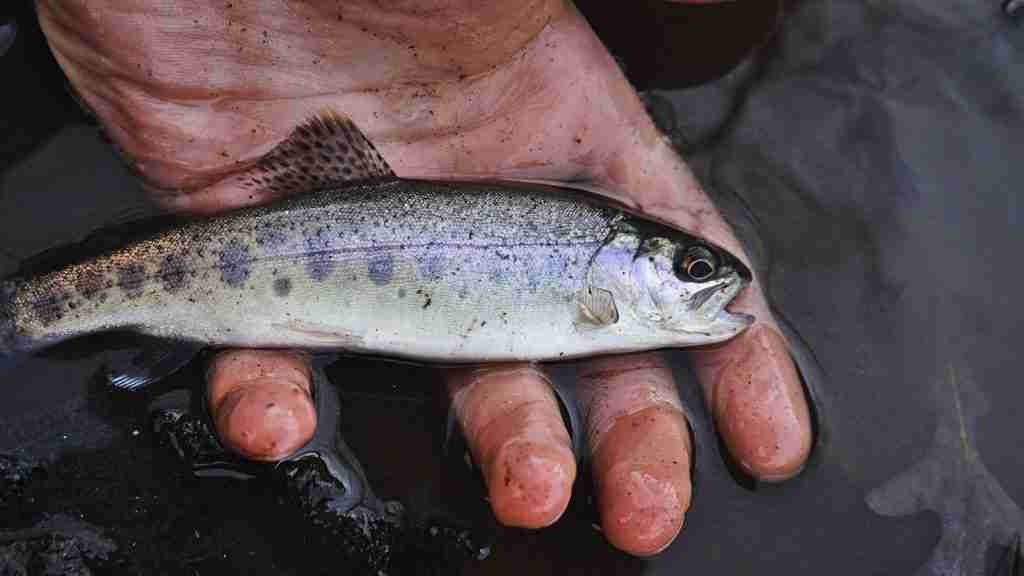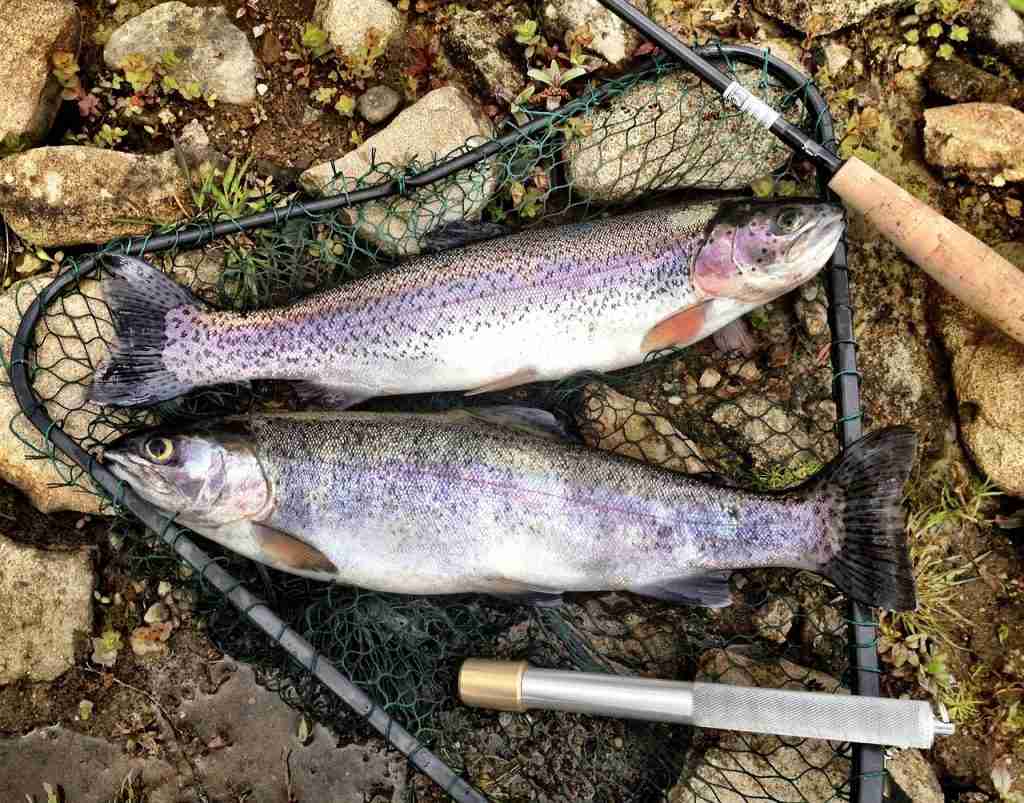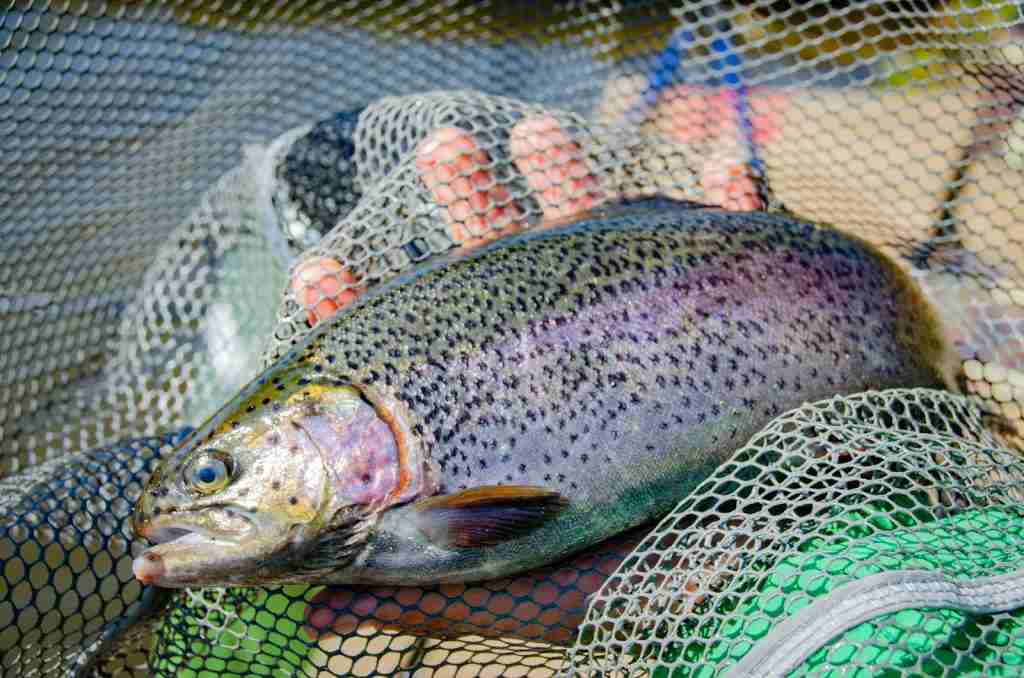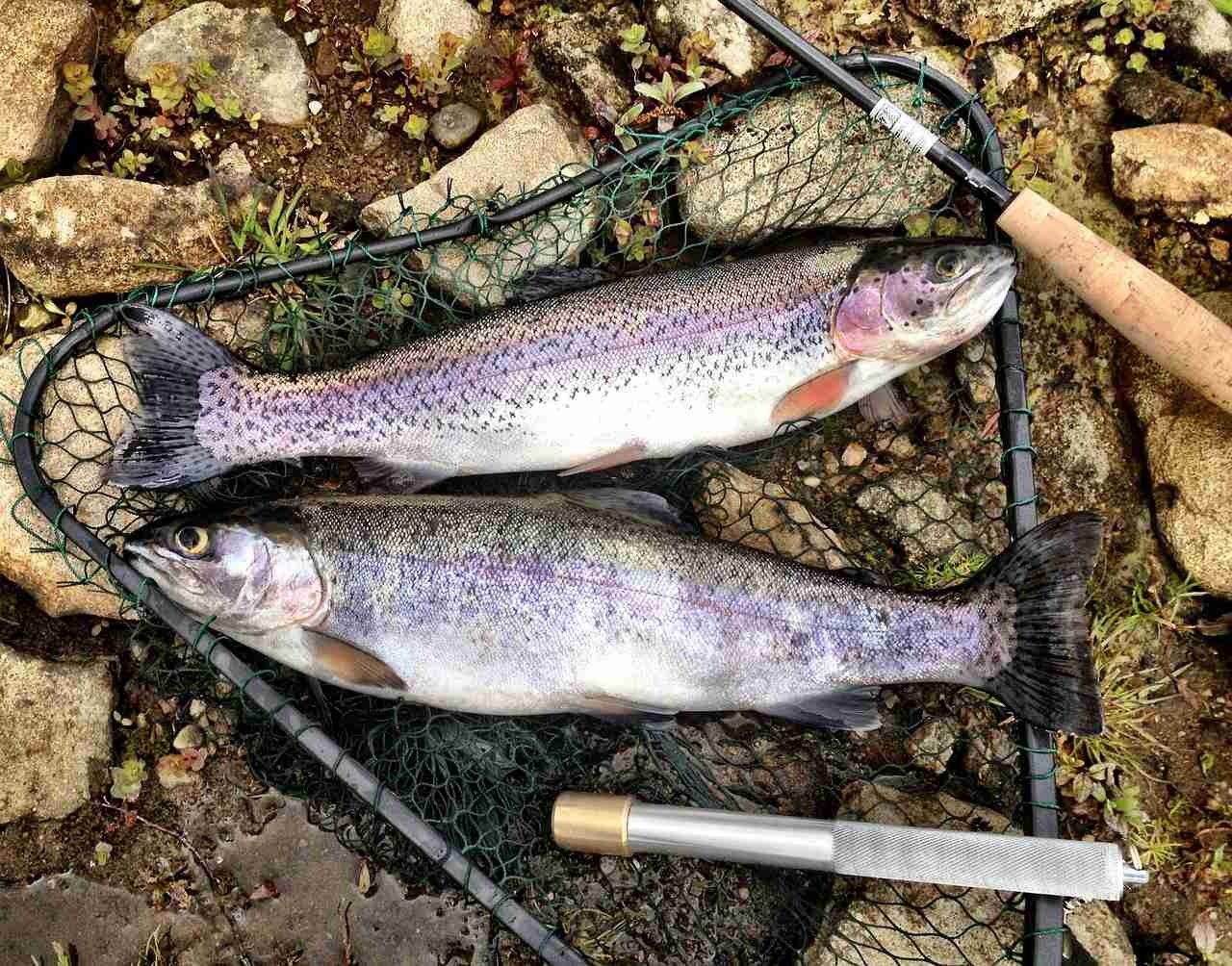25 Facts About Rainbow Trout You Need to Know
1. Rainbow trout are a species of salmonid fish native to North America.
Rainbow Trout are a type of salmonid fish native to North America. They are renowned for their vibrant hues and distinctive red stripes that run along their bodies.
Anglers frequently target them for their sporty behavior, as they exhibit vigorous resistance when caught. In their natural habitats of North American waterways, Rainbow Trout play crucial roles in the local ecosystems.
2. The Rainbow Trout is scientifically known as Oncorhynchus mykiss.
Scientifically known as Oncorhynchus mykiss, the Rainbow Trout is native to the cold-water tributaries of North America. Additionally, the steelhead, also referred to as steelhead trout, is an anadromous variant of the coastal rainbow trout (O. mykiss).
Both share the same scientific classification.
3. Rainbow Trout displays diverse colorings influenced by environment, age, and spawning conditions.
Rainbow Trout exhibit a variety of colors influenced by factors such as their habitat, age, and spawning conditions. The hues of their scales can range from vibrant reds to subtle blues and greens, reflecting the diversity of their environments.
As Rainbow Trout mature, their coloration may intensify or change, adding further complexity to their appearance. During the spawning season, their colors may become more pronounced as they prepare for reproduction.
4. They are carnivorous, feeding primarily on insects, crustaceans, and other small fish.
Rainbow trout are opportunistic feeders that are capable of consuming a wide variety of prey items. Their diet primarily consists of small aquatic insects such as mayflies, caddisflies, and stoneflies, as well as crustaceans like crayfish and small shrimp.
They will also eat other small fish, such as minnows and sculpin, as well as fish eggs and fry. In some cases, larger rainbow trout have been known to feed on smaller members of their own species.
5. Rainbow Trout has 15 different types.

The Rainbow Trout encompasses a diverse range of subspecies, totaling 15 distinct types. Among the most renowned species are the Coastal Rainbow Trout (Oncorhynchus mykiss irideus), commonly found along the Pacific coastline, and the Columbia River Redband Trout (Oncorhynchus mykiss gairdneri), known for its vibrant red markings and inhabiting the Columbia River basin.
Each subspecies exhibits unique characteristics, ranging from coloration patterns to habitat preferences, contributing to the overall richness and diversity of the Rainbow Trout species.
6. The largest Rainbow Trout on record weighed 48 pounds from Canada’s Lake Diefenbaker in 2009.
In 2009, angler Sean Konrad reeled in a whopper of a rainbow trout on Canada’s Lake Diefenbaker, shattering the all-tackle world record.
This behemoth weighed a mighty 48 pounds, dwarfing the record held by his twin brother just two years earlier.
7. Rainbow Trout typically live for 4 to 6 years on average in the wild.
Wild rainbow trout live an average of 4-6 years, but this can vary depending on their environment. Clean water with plenty of food helps them reach their full lifespan, while predators and limited food can shorten it.
Some exceptional trout, especially steelhead, can even live up to 20 years.
8. Rainbow trout have a complex life cycle that involves spawning, hatching, and maturation.
The life cycle of Rainbow Trout is intricate, encompassing several stages from spawning to hatching and maturation. It begins with spawning, where adult trout lay their eggs in gravel beds of freshwater streams.
After hatching, the young trout, known as fry, emerge and start their journey towards maturation. As they grow, they undergo various developmental phases before adulthood, including parr and smolt.
9. Rainbow trout are able to detect polarized light, which helps them navigate and locate prey.

Rainbow Trout possesses the remarkable ability to detect polarized light, a skill that aids them in navigation and prey detection.
This unique sensory adaptation allows them to perceive subtle changes in light polarization patterns underwater, enhancing their hunting efficiency and overall survival in their aquatic habitats.
10. A group of rainbow trout is called a hover.
A cluster of Rainbow Trout is referred to as a hover, signifying their collective presence in a particular area of their habitat. This term reflects their tendency to congregate in groups, often observed in freshwater streams and rivers.
The concept of a hover highlights the social dynamics and behavior of Rainbow Trout as they navigate their environment together.
11. Rainbow trout coloration can vary depending on their age, sex, and environmental factors.
The coloration of rainbow trout can vary depending on a variety of factors, including age, sex, and environmental conditions. Younger fish often exhibit brighter and more vibrant colors, while older fish tend to be darker and less colorful.
Additionally, the coloration of rainbow trout can be influenced by factors such as water temperature, light intensity, and the presence of other fish. Male rainbow trout, particularly during spawning season, may develop a more colorful appearance, including bright red or pink stripes and spots.
12. Rainbow Trout can be found on every continent except Antarctica.
Rainbow Trout, a highly adaptable species, inhabit various continents worldwide, except Antarctica. Their distribution spans across North America, Europe, Asia, Africa, and Australia, showcasing their remarkable ability to thrive in diverse environments.
Whether in cold mountain streams, pristine lakes, or even certain coastal regions, Rainbow Trout have established populations across a wide geographic range.
13. Rainbow trout are known to exhibit territorial behavior and can be aggressive towards other fish.
Rainbow trout are known to be territorial fish and will often defend a specific area of a stream or river from other fish.
This behavior can be particularly pronounced during spawning season when males will aggressively defend their territory from other males.
Additionally, larger rainbow trout may exhibit cannibalistic behavior and feed on smaller members of their own species.
14. Rainbow trout can jump out of the water, making them difficult to catch.
Rainbow trout are notorious escape artists. Their powerful muscles propel them out of the water in spectacular leaps, often exceeding six times their body length.
This impressive acrobatics helps them evade predators and navigate rapids, but it also makes them a challenging catch for anglers.
15. Rainbow Trout prefer temperatures between 32 and 70 degrees Fahrenheit.
Rainbow trout are like aquatic Goldilocks – temperature matters. Crystal-clear streams between 32 and 70 degrees Fahrenheit are their ideal habitat. This cool range keeps them energized, aids oxygen intake, and helps regulate their body temperature.
Warmer water can be stressful, slowing their movements and making them vulnerable to predators.
16. Rainbow Trout are rich in nutrients such as Omega-3 fatty acids, protein, vitamin D, and vitamin B12.
Rainbow trout aren’t just beautiful fish; they’re a nutritional powerhouse. Each bite packs a punch of omega-3 fatty acids, essential for brain function and heart health. They’re also a fantastic protein source, keeping you fuller for longer.
Plus, rainbow trout are swimming with vitamin D, which is crucial for strong bones, and vitamin B12, which helps convert food into energy.
17. Rainbow trout can be infected by a variety of diseases and parasites.
Like many fish species, rainbow trout are susceptible to various diseases and parasites, including bacterial and viral infections, fungi, and parasitic worms.
Some of the most common diseases affecting rainbow trout include bacterial coldwater disease, infectious hematopoietic necrosis, and whirling disease, which is caused by a parasitic worm. Parasites that can infect rainbow trout include fish lice, tapeworms, and roundworms.
18. Female Rainbow Trout can lay anywhere from 200 to 8000 eggs per spawning season.
Female rainbow trout are masters of maternity. They can release 200 to 8,000 eggs in a single season—talk about a baby boom. But here’s the shocker: only a tiny fraction survive.
This strategy, called r-selection, ensures some offspring make it despite the odds, perpetuating the rainbow trout legacy in the face of predators and environmental challenges.
19. Predators of Rainbow Trout include kingfishers, eagles, herons, raccoons, and humans.

Rainbow trout aren’t at the top of the food chain. They have to watch their backs for various predators. From the skies, sharp-eyed kingfishers, eagles, and herons snatch unsuspecting trout near the surface.
In the water, otters are relentless hunters, while sly raccoons snatch eggs or unwary fish. Even humans, with their clever fishing techniques, pose a big threat.
20. Rainbow Trout possess seven fins.
Rainbow trout are masters of maneuverability thanks to their seven fins! They have a single dorsal fin on their back for stability, a powerful caudal fin (tail fin) for propulsion, and a pair of pectoral fins on either side behind their heads for steering.
Additionally, they have a pair of pelvic fins closer to their belly for balance and a small adipose fin near the dorsal fin, believed to help with water flow. Finally, a tiny anal fin near their vent helps keep them upright.
21. Rainbow trout are an important sport fish species.
Reel in the excitement! Rainbow trout are prized sport fish worldwide. From the crystal-clear mountain streams of Montana to the serene lakes of New Zealand, anglers cast their lines in pursuit of these feisty fighters.
Their dazzling colors, acrobatic leaps, and battling spirit make catching a rainbow trout a thrilling experience that connects anglers to nature.
22. They are cannibalistic, with larger trout sometimes preying on their smaller kin.
Rainbow trout have a dark side. In times of low food availability, larger trout see their smaller relatives not just as neighbors but as a potential meal.
This cannibalistic behavior ensures they survive despite scarce resources, but it’s a surprising twist for such beautiful fish.
23. Rainbow Trout are recognizable by their distinct red stripe.
Forget the rainbow – it’s the red stripe that truly defines a rainbow trout. This vibrant band, running along their lateral line from gills to tail, is a dazzling trademark.
While their bodies shimmer with green, blue, and sometimes even purple hues, the red stripe is the constant, making them instantly recognizable underwater or on your dinner plate.
24. These trout are known for their energetic fighting ability.

Don’t underestimate the fight in a rainbow trout. These fish are feisty athletes. Hook one, and be prepared for a heart-pounding battle.
Their powerful muscles propel them on acrobatic leaps, head shakes, and determined runs, testing your skills and reflexes. Reeling in a rainbow trout is more than just catching a fish – it’s an exhilarating tug-of-war with a spirited opponent.
25. Rainbow Trout possess a keen sense of smell.
Rainbow trout are sensory superstars. Their keen sense of smell is like an underwater GPS. They can detect food sources from amazing distances, like insects or small fish. But that’s not all. They also boast impressive hearing.
Rainbow trout pick up on vibrations and sounds in the water, helping them navigate, avoid predators, and even detect potential prey. It’s like having built-in sonar and a super sniffer – a winning combo for survival in the aquatic world.
FAQS
Rainbow Trout is generally considered a delicious and nutritious fish to eat. Its flesh is mild and delicate, with a slightly nutty flavor. It can be prepared in various ways, including grilling, baking, broiling, or pan-frying. Rainbow Trout is also a good source of protein and essential nutrients such as omega-3 fatty acids, vitamin D, and B vitamins.
Trout are often attracted to a variety of colors, but some combinations are particularly effective. Among the most appealing colors for trout are yellow/black, red/yellow, and black/fluorescent. These combinations mimic natural prey items such as insects, crustaceans, and small fish, which are commonly found in trout habitats.
Whether Rainbow Trout is better than Salmon depends on personal preferences, nutritional content, and culinary uses. Rainbow trout has a milder flavor and softer texture than salmon, which some people prefer. Rainbow trout often have lower levels of fat and calories than some species of salmon, making it a healthier option for those watching their dietary intake. However, Salmon is typically richer in omega-3 fatty acids, which are beneficial for heart health. Culinary preferences also play a role, as Salmon is often favored for its robust flavor and versatility in cooking methods, while Rainbow Trout may be preferred for its delicate taste and suitability for more subtle preparations.
The best bait for Rainbow Trout varies depending on factors such as location, season, and fishing conditions. However, some commonly used baits include live bait such as worms, minnows, and insects like grasshoppers or crickets. Artificial baits such as spinners, spoons, and soft plastic lures can also be effective. Experimenting with different baits and observing local fishing regulations can help determine the most successful bait for Rainbow Trout in a particular fishing spot.
The best method for catching Rainbow Trout depends on various factors such as location, season, and fishing preferences. Some popular methods include fly fishing with dry flies, nymphs, or streamers, especially in rivers and streams. Spin fishing with spinners, spoons, or bait such as worms or PowerBait can also be effective, particularly in lakes or ponds. Trolling with lures or bait from a boat is another productive method, especially for targeting larger Rainbow Trout in deeper waters.







